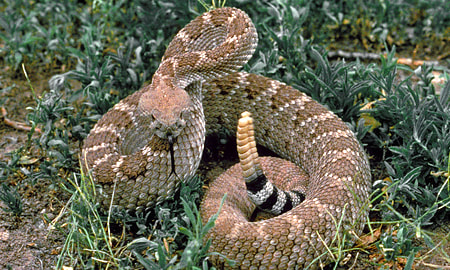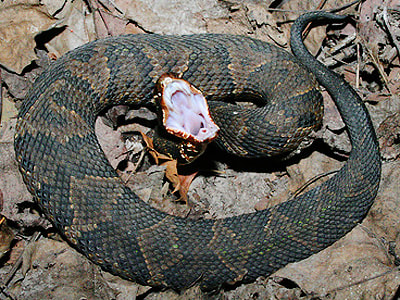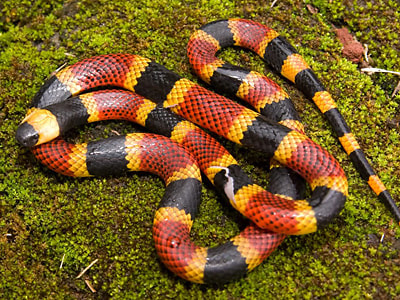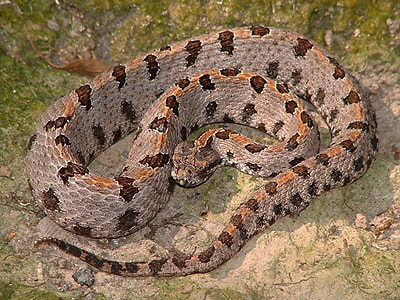Common Venomous Snakes in the USA
|
Eastern Diamondback Rattlesnake
The eastern diamondback rattlesnake (Crotalus adamanteus) is the largest of about 50 snake species in the USA. They are large, heavy-bodied snakes with large, broad heads with two light lines on the face. Adults are usually 33-72 inches long, and can tip the scales at over 10 lbs. The background color is brown, tan, or yellowish and covered with the namesake diamonds, which are brown and surrounded by lighter scales. Males are larger than females. Eastern diamondbacks are found throughout the southeastern United States. Their range includes eastern Louisiana, southern Mississippi, Alabama, Georgia, eastern South Carolina, southern North Carolina and all of Florida. |
|
Western Diamondback Rattlesnake
The western diamondback rattlesnake (Crotalus atrox) is a heavy bodied snake with a triangular shaped head. There are two dark diagonal lines on each side of its face running from the eyes to its jaws. It has dark diamond-shaped patterns along is back. The tail has black and white bands just above the rattles. This snake ranges in size from 3 to 5 feet long with a few reaching 7 feet long. This species ranges throughout the southwestern United States (Arizona, California, New Mexico, Oklahoma and Texas) and northern half of Mexico |
|
Timber Rattlesnake
Timber rattlesnakes, which are called canebrake rattlesnake in the Coastal Plain of the Southeast, live in a variety of habitats, including mountainous or hilly forests, hardwood or pine forests, swamps and river floodplains, lowland cane thickets, and agricultural fields. Generally, those found in the western and higher altitude parts of its range are called timber rattlers. They are large, heavy bodied snakes with solid black tails that appear almost velvet and black chevrons on the back and sides with the point of the (V) pointing forward. Adults range from 30-60 inches long. |
|
Mojave Rattlesnake
Mojave rattlesnakes inhabit desert areas of the southwestern United States and central Mexico—mainly southern California, Nevada, Utah, Arizona, Texas, and New Mexico. They are a tan, olive, or gray-brown rattlesnake with a series of dark blotches running down the back. The blotches have dark edges and uniform brown, dark gray, or olive-brown centers. As they near the tail the blotches gradually morph into cross bands. The tail is often pale gray with black, dark gray, or gray-brown rings that are narrower than the space between them. A thin, light colored stripe extends back from the posterior corner of the eye to beyond the corner of the mouth. The pupils are vertically elliptical. The base of the tongue is purple. The neck is slender and the head is broad and triangular. |
|
Cottonmouth
Cottonmouths are venomous semi-aquatic snakes often referred to as “water moccasins.” They range from southeastern Virginia to Florida, west to central Texas and north to southern Illinois and Indiana. They primarily live in aquatic and wetland habitats, including swamps, marshes, drainage ditches, ponds, lakes and streams. They have large, triangular heads with a dark line through the eye, elliptical pupils, and large jowls due to the venom glands. Older adults are often dark and solid-colored whereas the juveniles are brightly patterned with a sulphur yellow tail tip that they wiggle to attract prey. The belly typically has dark and brownish-yellow blotches with the underside of the tail being black. |
|
Copperhead
Copperheads are heavy-bodied snakes with large, triangular heads and elliptical pupils (cat eyes). The body is tan to brown with darker hourglass-shaped crossbands down the length of the body. They range throughout the eastern and central United States but are absent from most of Florida and south-central Georgia. The head is solid brown, and there are two tiny dots in the center of the top of the head. Juveniles resemble adults but have a bright yellow tail tip. As pit-vipers they have facial pits that sense heat and are used to detect prey and predators. Male copperheads are larger than females. |
|
Coral Snake
Adult eastern coral snakes are slender and medium sized -- 18-30 inches long. They have smooth scales and the anal plate is usually divided. The most obvious feature of an eastern coral snake is the bright body pattern of red, yellow, and black rings in which the red and yellow rings touch each other. The nose is black. It is the only eastern species of snake with a pair of fixed fangs in the front of the mouth. Eastern coral snakes are relatives of the cobra, mamba, and sea snake. They live in the wooded, sandy, and marshy areas to the southern coastal plains from North Carolina to Louisiana, including all of Florida. |
|
Pygmy Rattlesnake
This small -- 14–22 inches long -- rattlesnake belongs to the genus Sistrurus and is commonly referred to as a pigmy rattler or ground rattler. This species has nine large scales on top of the head and a tiny rattle that can seldom be heard. There are three subspecies of pigmy rattlesnakes, of which two occur in Georgia – the Carolina pigmy rattler and the dusky pigmy rattler. Both subspecies have a row of mid-dorsal spots and a bar than runs from the eye to the base of the mouth, but the color of this bar can vary from black to brownish red. An orange or reddish brown dorsal stripe is also present on both subspecies. The Carolina pigmy rattler can be gray, tan, or lavender. |









